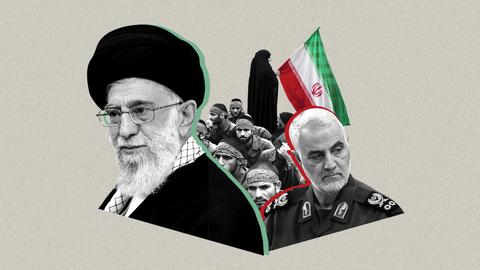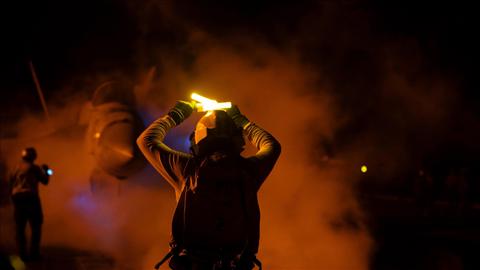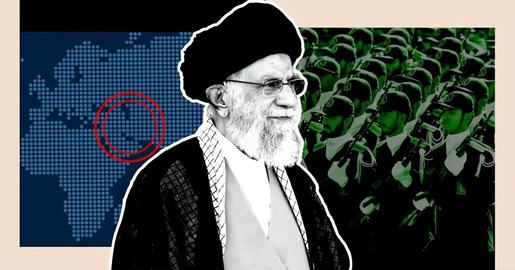The Islamic Republic knows that escalating the war in the Middle East risks direct confrontation with the United States, the potential loss of large numbers of IRGC soldiers and perhaps more popular unrest. Yet Iran’s Supreme Leader Ali Khamenei has long pursued proxy battles in the region and may think this is the right time to fulfil his decades-long dream of forcing the United States out of the Middle East.
A week after three of its soldiers were killed by Iran’s allies in a drone strike in Jordan the United States followed through on its threat in response to the attack.
The US military launched a series of airstrikes targeting dozens of sites in Iraq and Syria, all used by militias backed by Iran.
US President Joe Biden said targeting militants linked to the Islamic Republic’s “Axis of Resistance” was the start of his country’s response to the Jordan strike.
This operation appears to be the most extensive attack on positions related to Iran since Operation Praying Mantis in April 1988, when the direct involvement of Islamic Revolutionary Guards Corps (IRGC) forces in damaging a warship with a mine in the Persian Gulf prompted the United States to retaliate.
The United States targeted oil platforms, causing significant damage to Iran’s naval power in the Persian Gulf. According to Admiral Mohammad Hassan Malekzadegan, the commander of the Iranian Navy at the time, the operation resulted in 64 casualties and the loss of two warships.
Iran’s complaint to the International Court of Justice during President Ali Akbar Hashemi Rafsanjani’s administration resulted in a ruling in 2003 that the US attack did not violate international law or US government obligations.
Operation Praying Mantis added pressure on Iran to agree to a ceasefire with Iraq a few months later, ending the eight-year Iran-Iraq War.
United States, Between Iraq and a Hard Place
The consequences of the latest US attacks on the Iranian-backed militias in Syria and Iraq are hard to predict.
In 1988 the Soviet Union was on the brink of collapse and the United States had few rivals for the role of global policeman.
Today the United States itself is consumed with domestic political differences ahead of next November’s presidential election, and many Americans have no desire to be involved in another war in the Middle East.
At the same time, Biden may have no choice but to directly confront Iran at a time when the Islamic Republic is taking advantage of the chaos in the region and the world while struggle to provide the basics for its citizens.
US aid for Ukraine has been placed in jeopardy by Republican resistance, and Vladimir Putin claims alliance with the Islamic Republic in the rapidly-expanding Middle East conflict.
Constant attacks by the Iranian-backed Houthis on commercial ships in the Red Sea have caused enormous disruption to global trade, forcing many shipping companies to take the longer route from Asia to Europe around the Cape of Good Hope, and throwing Egypt into economic peril.
The Middle East and the world have not experienced such a level of chaos and volatility in our lifetimes. And that makes Khamenei a very happy Supreme Leader.
Khamenei’s Proxies in Iraq and Syria
Since the overthrow of Saddam Hussein Iran has maintained a long-term presence in Iraq, culminating in a security agreement with the country’s government.
After the fall of Saddam Hussein the Islamic Republic started to support a number of militia groups in Iraq which fought against Sunni groups to prevent them from regaining power. They also attacked US and British forces with improvised explosive devices (IEDs) in southern Iraq, aiming to expel US forces from the country and, eventually, the Middle East.
Both Khamenei and military commanders in Tehran have explicitly articulated that their goal is to drive Americans from the region.
Under the guidance of Khamenei and the leadership of Qasem Soleimani, the commander of the Quds Force of the IRGC’s extraterritorial branch from 1997 to 2020, several militia groups established in Iraq were replicated in Syria after the Arab Spring and the violent suppression of citizens’ protests against Bashar al-Assad. Soleimani was killed by US forces along with a leader of an Iraqi militia in January 2020.
A devious and experienced tactician, who had served for eight years as a commander in the Iran-Iraq War (1980-88), Soleimani created the unofficial and paramilitary structure of Iran’s proxies and increased their power and influence among different tribes in various parts of in Syria and Iraq. This loose structure has provided the Islamic Republic with an opportunity to enhance its influence in those countries with little investment or direct military presence.
Through Iran’s proxies Khamenei has engaged in a war of attrition with the United States that has comprised of limited yet successive and continuous strikes against US interests and targets, without officially acknowledging responsibility or reaping consequences.
In moments such as after the recent killing of the three American soldiers in Jordan the Islamic Republic verbally retreated, abdicating responsibility for the militia groups’ actions, calling the attack “an independent operation by a resistance group.”
US Restraint Will Enable Further Attacks
The ultimate outcome of the current US operations in Iraq and Syria and the level of deterrence they will create remain uncertain. But what is certain is that restraint from the United States will lead to more attacks by Iran’s proxies. Traditionally, whenever the American military threat subsided Iran resumed providing support to these militias.
Neither Iran nor the US have any interest in a direct conflict. But the situation seems untenable. Khamenei’s policies have turned Iraq and Syria into Iran’s proxy states, a fact that even Iranian allies may not tolerate in the long term. And after 35 years, the United States, against its wishes, finds itself on the brink of a direct military confrontation with Iran.
The Islamic Republic has recalled its senior military commanders from Syria and Iraq, and while tensions may temporarily decrease to ease the situation and mitigate the danger, the region remains in an extremely volatile state.
Biden took his country out of a 20-year war in Afghanistan and was not seeking another one, but his wish may not be realised.
As the campaign for the 2024 presidential election in the United States heats up, Donald Trump will take every opportunity to make Biden look like a weak leader who is failing to cope with threats from authoritarian regimes.
Khamenei, however, does not have to answer to voters, and for now it seems the Islamic Republic will largely benefit from the turmoil in the region and at home in the United States.
visit the accountability section
In this section of Iran Wire, you can contact the officials and launch your campaign for various problems




















comments